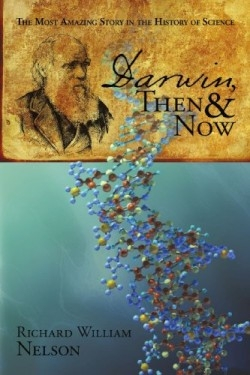Darwin, Then & Now
Everybody recognizes the Jesus Fish on the back of a car; a legged version with “Darwin” on the fish’s belly instead of “Jesus” is also available. Continuing the clash between creationists and evolutionists is an even larger Jesus Fish, swallowing the Darwinian critter head first. It is in this spirit that Darwin, Then and Now is presented.
This point of view is not evident from the book’s cover, which trumpets the sub-title, “The Most Amazing Story in the History of Science,” but on the first page Nelson provides an arresting comparison of Abraham Lincoln and Charles Darwin, who shared the same birthday, February 12, 1809. “Lincoln sought the emancipation of men from men,” Nelson writes, “and Darwin sought the emancipation of men from God.” Most scholars and biographers of Darwin would disagree with this statement, noting that he was reticent about publicly disavowing the religious tenets he studied as a Cambridge theology student. Rather, he was focused—some might say obsessed—on refining his evolutionary theories in an effort to understand how the natural world works.
The first section of the book offers an overview of Darwin’s life, as he evolved from an adolescent obsessed with shooting birds to a young man engrossed in the studies of geology and natural history. Nelson selects biographical snippets that highlight Darwin’s faults, giving readers the impression that Darwin was a lazy and dissolute rich boy and an indifferent student at an elite university that catered to “young men just like Darwin who had probably too much money and too little discipline.” Nelson also argues that “the Darwin’s [sic] were the Kennedy’s [sic] of the 19th century.” The Kennedy comparison is repeated at least twice, and other code phrases—like referring to “The Origin of Species” as the Harry Potter of its day—cue the reader about the book’s target audience.
The book’s middle section analyzes the author’s view that there are many contradictions and faults inherent in Darwin’s theories of natural selection and adaptation and here the simple, direct prose changes tone to become almost like a legal brief. For diehards in search of talking points to rebut Darwinian theories, there is much meat here, though the meat is dry.
Nelson’s book continues with a critical examination of Darwin’s theories, peppered with many short quotations from scientists and writers throughout the 150 years since The Origin of Species was published. Again, the back and forth style of writing will be of limited appeal to a general audience of popular science readers. Only an impassioned Darwin fan or foe would likely consume the chapters on paleontology, molecular biology, embryology, and genetics, though the author gets points for his extensive research and footnotes.
Darwin, Then and Now provides a counterpoint to the largely adulatory publications and events surrounding the sesquicentennial of The Origin of Species. It offers a clearly written, if sometimes densely outlined, perspective on Darwin’s scientific legacy, though its appeal seems limited to a conservative Christian readership.
Disclosure: This article is not an endorsement, but a review. The publisher of this book provided free copies of the book and paid a small fee to have their book reviewed by a professional reviewer. Foreword Reviews and Clarion Reviews make no guarantee that the publisher will receive a positive review. Foreword Magazine, Inc. is disclosing this in accordance with the Federal Trade Commission’s 16 CFR, Part 255.

